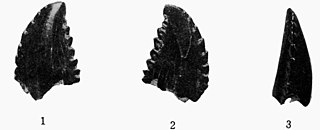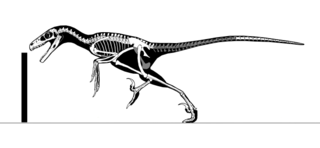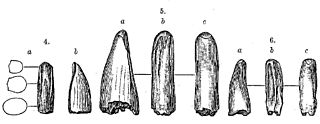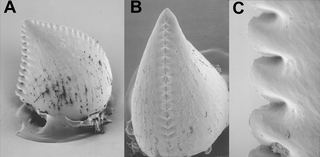
Troodon is a former wastebasket taxon and a potentially dubious genus of relatively small, bird-like theropod dinosaurs definitively known from the Campanian age of the Late Cretaceous period. It includes at least one species, Troodon formosus, known from Montana. Discovered in October 1855, T. formosus was among the first dinosaurs found in North America, although it was thought to be a lizard until 1877. Several well-known troodontid specimens from the Dinosaur Park Formation in Alberta were once believed to be members of this genus. However, recent analyses in 2017 have found this genus to be undiagnostic and referred some of these specimens to the genus Stenonychosaurus some to the genus Latenivenatrix, and some to the genus Pectinodon. The genus name is Ancient Greek for "wounding tooth", referring to the teeth, which were different from those of most other theropods known at the time of their discovery. The teeth bear prominent, apically oriented serrations. These "wounding" serrations, however, are morphometrically more similar to those of herbivorous reptiles, and suggest a possibly omnivorous diet.

Dromaeosaurus is a genus of dromaeosaurid theropod dinosaur that lived during the Late Cretaceous period, sometime between 80 and 69 million years ago, in Alberta, Canada and the western United States. The type species is Dromaeosaurus albertensis, which was described by William Diller Matthew and Barnum Brown in 1922. Its fossils were unearthed in the Dinosaur Park Formation. Teeth attributed to this genus have been found in the Prince Creek Formation. Dromaeosaurus is the type genus of both Dromaeosauridae and Dromaeosaurinae, which include many genera with similar characteristics to Dromaeosaurus such as possibly its closest relative Dakotaraptor. Dromaeosaurus was heavily built, more so than other dromaeosaurs that are similar in size, like Velociraptor.

Stenonychosaurus is a genus of troodontid dinosaur from the Late Cretaceous Dinosaur Park Formation of Alberta, Canada, as well as possibly the Two Medicine Formation. The type and only species, S. inequalis, was named by Charles Mortram Sternberg in 1932, based on a foot, fragments of a hand, and some caudal vertebrae from the Late Cretaceous of Alberta. S. inequalis was reassigned in 1987 by Phil Currie to the genus Troodon, which was reverted by the recognition of Stenonychosaurus as a separate genus from the possibly dubious Troodon in 2017 by Evans et al. and also later in the same year by Van der Reest and Currie.

Saurornitholestes is a genus of carnivorous dromaeosaurid theropod dinosaur from the late Cretaceous of Canada (Alberta) and the United States.

Richardoestesia is a morphogenus of theropod dinosaur teeth, originally described from the Late Cretaceous of what is now Canada, the United States and Kazakhstan. It currently contains two species, R. gilmorei and R. isosceles, and a possible third, R. asiatica. It has been used as a morphotaxon to describe other theropod teeth widely displaced in time and space from the type species. If all teeth assigned to the genus are truly reflective of the animals biology and taxonomic state, it would have been one of the longest lasting dinosaur genera, perhaps also being the most widely distributed.

Saurornithoides is a genus of troodontid maniraptoran dinosaur, which lived during the Late Cretaceous period. These creatures were predators, which could run fast on their hind legs and had excellent sight and hearing. The name is derived from the Greek stems saur~ (lizard), ornith~ (bird) and eides (form), referring to its bird-like skull.

Aublysodon is a genus of carnivorous dinosaurs known only from the Judith River Formation in Montana, which has been dated to the late Campanian age of the late Cretaceous period. The only currently recognized species, Aublysodon mirandus, was named by paleontologist Joseph Leidy in 1868. It is sometimes considered dubious now, because the type specimen consists only of an isolated premaxillary (front) tooth. Although this specimen is now lost, similar teeth have been found in many US states, western Canada, and Asia. These teeth almost certainly belong to juvenile tyrannosaurine tyrannosaurids, but most have not been identified to species level. However, it is likely that the type tooth belongs to one of the species in the genus Daspletosaurus, which was present in contemporary formations, and which matches specific details of the original tooth. The synapomorphies alleged to distinguish the Aublysodontinae, especially lack of serrations on premaxillary teeth could have been caused by tooth wear in life, postmortem abrasion, or digestion. Most other "aublysodontine"-type teeth may be from ontogenetic stages or sexual morphs of other tyrannosaurids.

Byronosaurus is a genus of troodontid dinosaur from the Late Cretaceous Period of Mongolia.

Pyroraptor is an extinct genus of paravian dinosaur, probably a dromaeosaurid or unenlagiid, from the Late Cretaceous Ibero-Armorican island, of what is now southern France and northern Spain. It lived during the late Campanian and early Maastrichtian stages, approximately 70.6 million years ago. It is known from a single partial specimen that was found in Provence in 1992, after a forest fire. The animal was named Pyroraptor olympius by Allain and Taquet in 2000.

Dyoplosaurus is a monospecific genus of ankylosaurid dinosaur from Alberta that lived during the Late Cretaceous in what is now the Dinosaur Park Formation. Dyoplosaurus represents a close relative of Scolosaurus and Anodontosaurus, two ankylosaurids known from the Horseshoe Canyon and Dinosaur Park Formation.

Zapsalis is a genus of dromaeosaurine theropod dinosaurs. It is a tooth taxon, often considered dubious because of the fragmentary nature of the fossils, which include teeth but no other remains.

Pectinodon is a genus of troodontid theropod dinosaurs from the end of the Maastrichtian age of the Late Cretaceous period (66 mya). It currently contains a single valid species, Pectinodon bakkeri, known only from teeth.

Koparion is a genus of small coelurosaurian theropod dinosaur, from the late Jurassic Period, of Utah. It contains the single named species Koparion douglassi which is known only from a single isolated tooth.
Dysganus (dis-GANN-us) is a dubious genus of ceratopsian dinosaur from the Campanian stage of the Late Cretaceous. The fossil teeth referred to Dysganus were first collected by Charles Sternberg from the Cretaceous Judith River Formation of Montana and later described by Edward Drinker Cope. All of the species are now seen as dubious Ceratopsians, though referred material from tyrannosaurids and hadrosaurids were found in New Mexico.

Euronychodon is the name given to a genus of coelurosaur dinosaur from the Late Cretaceous of Europe and Asia. Euronychodon is known from teeth only. These are similar to those of another coelurosaur tooth genus, Paronychodon.

Austroraptor is a genus of dromaeosaurid theropod dinosaur that lived during the Campanian and Maastrichtian ages of the Late Cretaceous period in what is now Argentina.

Xixiasaurus is a genus of troodontid dinosaur that lived during the Late Cretaceous Period in what is now China. The only known specimen was discovered in Xixia County, Henan Province, in central China, and became the holotype of the new genus and species Xixiasaurus henanensis in 2010. The names refer to the areas of discovery, and can be translated as "Henan Xixia lizard". The specimen consists of an almost complete skull, part of the lower jaw, and teeth, as well as a partial right forelimb.

Acheroraptor is an extinct genus of dromaeosaurid theropod dinosaur known from the latest Maastrichtian Hell Creek Formation of Montana, United States. It contains a single species, Acheroraptor temertyorum. A. temertyorum is one of the two geologically youngest known species of dromaeosaurids, the other being Dakotaraptor, which is also known from Hell Creek. A basal cousin of Velociraptor, Acheroraptor is known from upper and lower jaw material.

This timeline of troodontid research is a chronological listing of events in the history of paleontology focused on the troodontids, a group of bird-like theropod dinosaurs including animals like Troodon. Troodontid remains were among the first dinosaur fossils to be reported from North America after paleontologists began performing research on the continent, specifically the genus Troodon itself. Since the type specimen of this genus was only a tooth and Troodon teeth are unusually similar to those of the unrelated thick-headed pachycephalosaurs, Troodon and its relatives would be embroiled in taxonomic confusion for over a century. Troodon was finally recognized as distinct from the pachycephalosaurs by Phil Currie in 1987. By that time many other species now recognized as troodontid had been discovered but had been classified in the family Saurornithoididae. Since these families were the same but the Troodontidae named first, it carries scientific legitimacy.

Dineobellator is a genus of dromaeosaurid theropod dinosaur that lived in North America during the Late Cretaceous period 68 million years ago. The remains have been found in the Maastrichtian stage of the Naashoibito Member at the Ojo Alamo Formation, New Mexico.




























